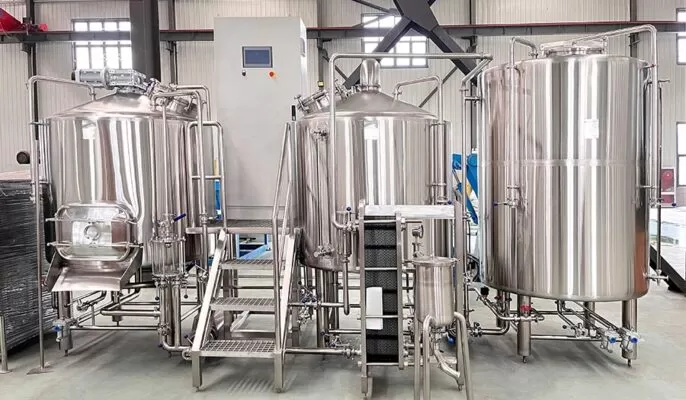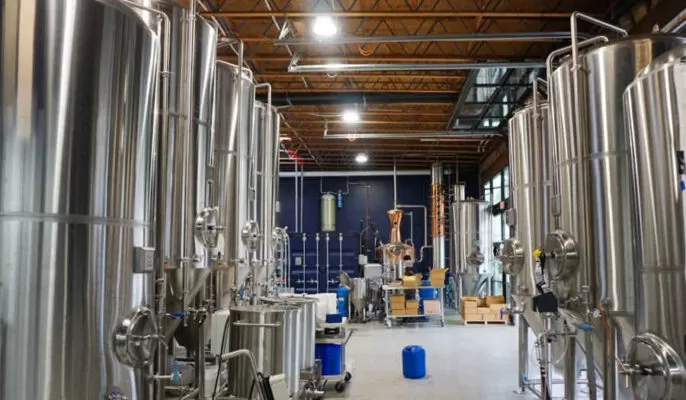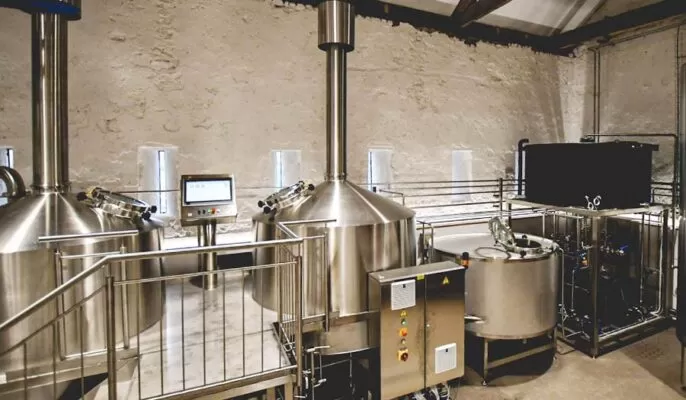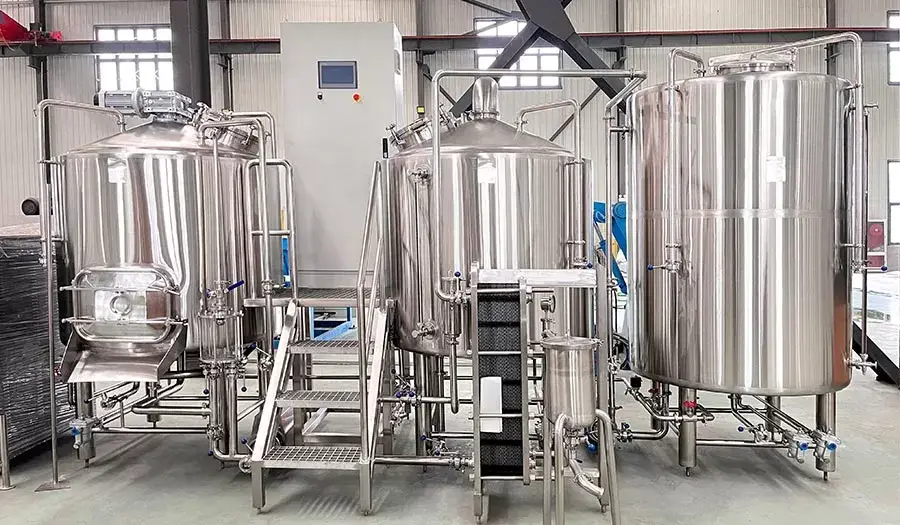Overview of Nano Brewing Systems
Homebrewing and craft brewing have seen a surge in popularity in recent years. However, the equipment required can take up lots of space and be complicated to operate. This is where nano brewing systems come into play.
Nano breweries are compact, easy-to-use systems designed for brewing small batches of beer at home or for a microbrewery producing craft beer on a small scale. The nano equipment allows for end-to-end beer production with mashing, lautering, boiling, fermenting, carbonating and packaging all done with an automated, integrated system.
Key advantages of nano brewing equipment:
- Compact footprint – nano systems take up less than 4 sq ft of floor space
- Automated process – pre-programmed recipes and settings for simplified brewing
- Scalable batches – produce 1 to 10 gallons per brewing cycle
- Shorter brew times – nano equipment can cut typical brewing time in half
- Minimal manual labor – less lifting, stirring, temperature monitoring needed
- Lower startup costs – systems under $2000 ideal for homebrewers
- Modular design – start small and expand tanks, kettles as needed
In this comprehensive guide, we will explore the different types of nano brewing equipment available and their key features. Whether you want to brew beer as a hobby or start your own microbrewery, understanding the capacity, automation, customization and cost considerations will help you choose the ideal nano brewing system.

Nano Brewing Equipment Types
There are a few core components that make up a complete nano brewing system. Here are the key pieces of equipment needed:
Nano Brewing Systems Table
| Equipment | Description |
|---|---|
| All-in-one Electric Brew-in-a-Box | Integrated system with heating elements, pump, temperature control for mashing, boiling, fermenting. Compact and automated. |
| Brewing Kettle | Stainless steel brew kettle with heating element for mashing grains and boiling wort. 1-10 gallon capacity. |
| Lauter Tun | Container for lautering – separating wort from spent grains. Perforated false bottom allows wort drainage. |
| Fermentation Tank | Stainless steel or plastic tank with temperature control for fermenting beer. 1-10 gallon capacity. |
| Brite Tank | Pressurized stainless steel tank for carbonating and storing finished beer. 1-5 gallon capacity. |
| Chiller | Wort chiller using cold water or refrigerant to rapidly cool boiled wort before fermentation. |
| Racking Tools | Tubing, cane, bottling wand to transfer beer between vessels with siphon or pump. |
| Sanitization Equipment | Spray bottles, tubing brushes, chemicals like Star San for cleaning/sanitizing system. |
Beyond these core components, additional equipment like kegging systems, yeast propagation, water filtration, grain mills, bench capper and labeling machine may be added as a nano brewery expands production and packaging capabilities.
Determine your target batch size, degree of automation, and budget to select the right nano brewing system components for your needs.
Applications of Nano Brewing Equipment
| Use Case | Details |
|---|---|
| Homebrewing | Nano systems are ideal for brewing beer as a hobby. Produce 1-5 gallon test batches. Customize recipes. |
| Microbrewery | Startup craft brewers can begin commercial production on a nano scale before expanding. |
| Brewpub | Brew and serve fresh craft beer onsite at a brewpub or tasting room. |
| Brew-on-premises | Subscription membership services for brewing beer on automated nano equipment. |
| Small batch innovation | Test and refine recipes at nano scale before full production. Lower risk for R&D. |
Key advantages of nano brewing equipment for these use cases:
- Lower startup cost and space requirements
- Simplified process automation – no brewing experience needed
- Formulate innovative beer recipes in small test batches
- Bring new beer styles to market rapidly
- Provide freshly brewed craft beer with maximum flavor and aroma
With their compact size and automated operation, nano brew systems enable small-scale beer production almost anywhere for both hobbyists and commercial breweries alike.
Nano Brewing System Specifications
Key technical specifications to look for when choosing nano brewing equipment:
| Parameter | Typical Range |
|---|---|
| Batch Size | 1-10 gallons |
| Dimensions | 2-4 ft W x 4-6 ft H x 2-3 ft D |
| Weight | 50-300 lbs |
| Construction | Stainless steel or aluminum kettles, food-grade plastic fermenters |
| Temperature Control | Digital PID controllers, RTDs, thermistors |
| Heating Power | 2000-5000W, 120V or 240V supply |
| Pumps | Magnetic drive, stainless impellers, 1/10 to 1/2 HP |
| Automation | Pre-programmed recipes, automated valves, sensors |
| Monitoring | Digital displays of time, temperature, pressure, gravity |
| Electrical Power | 110/220V, 15/30 amp circuits recommended |
Consider tank volume, degree of automation, accuracy of process control, and electrical requirements when selecting a system. Get technical guidance from nano brewing equipment suppliers.
Nano Brewing System Manufacturers
| Company | Key Products | Description |
|---|---|---|
| Picobrew | Zymatic, Pico C | Fully automated brewing with beer recipe creation software. 1-5 gallon batches. |
| Brewie | Brewie, Brewie Pro | Integrated brewing appliance with touchscreen interface. 0.5-10 gallon batches. |
| Speidel | Braumeister | All-in-one electric brew system rated up to 10 gallon batches. |
| Grainfather | Grainfather Conical | 30 or 55 liter stainless fermenter + modular brewing accessories. |
| Robobrew | Robobrew V3 | Electric malt handling and boiling system. Add fermenter separately. |
| MiniBrew | CraftBeerPi | Open source brewing with Raspberry Pi automation. Modular tanks. |
| Hop Tech | Hop Tech Draft | 2-10 gallon brewing for brewpubs. Automated clean-in-place (CIP). |
Research multiple vendors to compare nano system prices, capacity, features, configurability, and reviews.
Nano Brewing System Pricing
| Equipment | Starter Kit Cost | Additional Components |
|---|---|---|
| Picobrew Zymatic | $350 | Fermentation keg $79+ |
| Brewie | $1990 | Additional brewing modules $350+ |
| Grainfather Conical | $999 | Fermenter $199+, kegging kit $299+ |
| Speidel Braumeister | $3800 | Additional vessel $250+, kegging kit $329+ |
| Robobrew V3 | $1075 | Fermentation kit $450+, kegging kit $229+ |
| CraftBeerPi | $300+ | Modular kettles, fermenters, kegs |
| Hop Tech Draft | $7000+ | CIP modules, additional kegs |
This table shows starter package prices as well as costs for common add-ons like fermenters, kegs, and kegging equipment across major nano system brands. Prices can range from a few hundred dollars for partial systems aimed at homebrewers to several thousand dollars for fully integrated, automated nano brewing appliances for microbreweries.
Installing Nano Brewing Systems
Proper installation of a nano brewing system helps ensure safe, optimal operation. Follow these steps:
- Select a dry, level location with solid flooring and adequate ceiling height
- Have circuit panel upgraded if needed – install 30 amp 240V outlet for 4000W+ systems
- Build sturdy platform or stand if needed to position components at safe heights
- Read equipment manuals thoroughly – follow all installation instructions
- Connect kettles/tanks in correct sequence using provided hoses, fittings, valves
- Program controller with recipes and production parameters as directed
- Sanitize entire system with brewing cleaner and boiled water pre-use
- Start first brew session and monitor closely to confirm proper functioning
- Make any necessary adjustments to settings or procedures after initial trial run
Poor installation can lead to leaks, power issues, or equipment damage. Consult nano system vendor for technical guidance on proper setup.
Operating Nano Brewing Systems
Follow best practices when using a nano brewing system for beer production:
- Clean and sanitize all equipment prior to each use
- Measure out grains, hops, yeast carefully based on recipe
- Secure hoses, fittings, pumps to prevent leaks or clogs
- Adjust controller or app to programmed recipe settings
- Monitor key parameters like mash temp, boil time, fermentation temp
- Take gravity readings with hydrometer to track fermentation
- Avoid opening fermenter prematurely – allow full attenuation time
- Use tight cold-side protocols – avoid oxygen exposure after fermentation
- Chill beer quickly to ideal serving temp – store cold
- Record details on recipes, times, temperatures, gravities for each batch
- Perform preventative maintenance as directed – replace gaskets, fittings
- Fully clean and dry equipment after each use for storage
Proper techniques and diligent recordkeeping helps nano brewers consistently produce great beer batches. Always defer to equipment manuals for specific operating procedures.
Maintaining Nano Brewing Systems
Regular maintenance keeps nano brewing equipment in top working order:
- Descale any mineral buildup on heating elements using food-safe acid cleaners
- Lubricate seals, o-rings, and gaskets
- Inspect metal fittings, ball valves, bulkheads for cracks or leaks
- Check calibration on digital temperature and density sensors
- Test operation of pumps and heating elements
- Replace any worn or defective parts like hoses, taps, fittings
- Update firmware on controllers or automation systems
- Thoroughly clean and sanitize entire system between brew sessions
- Store fermenters and brite tanks empty and dry with doors open between uses
- Check for rodents or insects if storing system idle for extended periods
Follow all maintenance instructions provided by the equipment manufacturer. Keep a maintenance log to track service history.
Choosing a Nano Brewing System Supplier
Consider the following when selecting a nano brewing equipment provider:
- Range of equipment – offer complete systems plus add-ons and expansion options
- Production capability – experienced manufacturing brewing systems at commercial scale
- Product quality – high-grade stainless steel construction and components
- Customization – ability to spec tanks, automation, accessories to needs
- Customer support – provide guidance on installation, operation, troubleshooting
- Manuals and training – have complete equipment documentation and videos
- Reputation – read reviews and talk to existing customers about reliability
- Cost – balance performance with budget constraints
- Local availability – may need installation assistance or servicing
- Warranty and parts availability – support equipment over its usable lifespan
Finding the right manufacturing partner ensures a robust, customizable nano brewing system suited to your brewing goals and scale.
Pros and Cons of Nano Brewing Systems
Advantages of Nano Brewing Equipment
- Small footprint – fits in limited home or small commercial space
- Lower startup cost than large brewhouse equipment
- Simplified, automated process controls brewing for beginners
- Produce small test batches to develop recipes and techniques
- Modular systems allow gradually scaling up production capacity
- Portable units can be moved or expand into larger facilities
- Potential for creative innovative beers in a small system
- Lower risks due to reduced batch sizes and capital investment
- Systems create less waste water and energy use than large brewhouses
Disadvantages of Nano Brewing Equipment
- Manual labor still required for grain handling and cleaning
- Limited quality control vs automated sensory analysis
- Steep learning curve on proprietary automation and controllers
- Batch size limits total production volume and sales potential
- Additional equipment like keg washer often needed as production scales
- Require significant hands-on monitoring and troubleshooting
- Specifications like temperature control may lag pro-grade full-scale brewing
- Very small nano batches may limit ability to replicate results consistently
- Equipment costs may seem excessively high for homebrewers
Understand both the opportunities and limitations to determine if a nano brew system matches your skills, facilities and brewing goals.

How to Choose Between Nano Brewing Systems
Selecting the ideal nano brewing system for your needs depends on several factors:
Batch Size
- 1-3 gallon systems best for homebrewers and testing recipes
- 5-7 gallon systems suitable for brewpubs serving onsite
- 7-10+ gallon systems for packaging and wider distribution
Match system capacity to your target batch size and production schedule. Size up as your brewing goals grow.
Automation Level
- Manual systems like kettles with digital controllers require more brewing skill
- All-in-one systems simplify end-to-end brewing for beginners
- Review programmability – select automation suitable to expertise level
Seeking full automation? Look for pre-programmed recipes and monitoring. Comfortable brewing manually? Prioritize flexible equipment controls.
Available Space
- Measure area for equipment – consider heights for lifting kegs, fermenters
- Ensure adequate electrical service, ventilation, drainage
- Compact all-in-one systems under 4 sq ft best for tight spaces
- Look for modular components as space expands later
Choose nano equipment sized appropriately for current facilities, with room to add modules as operations grow.
Equipment Quality
- Medical-grade stainless steel provides durability and easy cleaning
- PID temperature controllers and RTD sensors enable precision
- Dial in equipment specs to match commercial brewery standards
- Prioritize quality that supports consistency at any batch size
For pro-level nano brewing, choose equipment meeting the highest construction, automation and process control standards.
Cost Considerations
- Startup budget – balance capability with affordability
- Expansion modules – evaluate base system vs add-ons pricing
- Shipping expenses – size and weight add to costs
- Installation needs – factor in electrician fees, materials
- Ongoing costs – maintenance, repairs, consumables
Project both upfront expenses as well as ongoing costs over the full equipment lifetime.
By carefully weighing these factors against your brewing objectives, you can determine the ideal nano brewing system setup for your specific needs and budget.
Applications and Role of Nano Brewing Equipment
Nano brewing equipment enables small-scale beer production in a variety of settings:
Homebrewing
Nano brewing systems are ideal for craft beer enthusiasts. Benefits include:
- Produce 1-5 gallon batches at home
- Mimic commercial brewing process
- Dial in recipes through iterative testing
- Try unique styles not available commercially
- Share creations with friends and family
- Enter homebrew competitions
- Low startup costs for equipment
- Learn about brewing science and techniques
- Satisfaction of drinking your own crafted beer
With their compact size and streamlined brewing process, nano systems allow excellent homebrewing results without extensive space or experience.
Microbreweries
For startup microbreweries, nano systems provide:
- Test recipes and bring concepts to market quickly
- Begin selling beer with lower capital investment
- Start on a nano system and expand in phases as demand grows
- Develop unique beers and build brewing skills
- Provide specialty small batches for onsite taprooms
- Retain flexibility before committing to full-scale equipment
- Move small footprint equipment to expanded facilities later
- Lower risks during early operations and iteration
- Build brand experience through brewery tours and tastings
The modularity and lower cost-to-enter makes nano brewing equipment an accessible starting point for commercial microbreweries.
Brewpubs
Nano brewing enables brewpubs to:
- Produce fresh beer onsite to serve guests
- Offer a wide range of beer styles and flavors
- Engage customers through viewable brewing operations
- Save on costs of transporting kegs from remote brewery
- Brew experimental and seasonal beers not available otherwise
- Showcase local ingredients and custom recipes
- Control ingredients and process for optimal quality
- Provide tours and education to build brand connection
- Generate social media buzz and reviews around new beer releases
The small batches and hands-on experience from nano brewing are a major draw for patrons of brewpubs and taprooms.
Brew-on-Premises
Also called brew-it-yourself establishments, these businesses provide access to nano brewing equipment for customers to produce their own beer. Benefits include:
- Provide equipment, space, and ingredients for brewing
- Offer guided classes and brewing assistance
- Customers can brew 5-10 gallon batches to take home
- Option to distribute to local bars and retailers
- Engage customers through brewing experience
- Lower startup costs than independent brewing
- Build community around shared hobby
- Simplified cleanup with shared equipment
- Supplementary revenue stream for breweries
By removing barriers to brewing, these services let anyone easily brew high-quality beer on nano systems.
Nano Vs Micro Vs Macro Brewing Equipment
Nano brewing systems occupy an important middle ground between homebrewing equipment and full-scale microbrewery or macro brewery installations.
| Parameter | Nano | Micro | Macro |
|---|---|---|---|
| Batch Size | 1-10 gallons | 10-15 bbl (310-465 gallons) | 100+ bbl |
| Brewhouse Size | 2-4 ft x 4-6 ft footprint | 500-1500 sq ft | 2500+ sq ft |
| Automation Level | Partial – fully automated | Moderate – semi-automated | Full – highly automated |
| Equipment Cost | $500-$5000+ | $100,000-$500,000 | $1,000,000+ |
| Production Volume | Under 500 bbl/year | 500-5000 bbl/year | 5000+ bbl/year |
| Target Market | Homebrewers | Local pubs, beer bars | Wider distribution |
Mashing and Lautering Equipment
- Nano – Integrated mash tuns around 5-10 gallons or separate kettles and lauter tuns
- Micro – Individual mash tuns and lauter tuns in the 10-100 bbl range
- Macro – Giant mash filters, lauter tuns, and mash mixers handling 500+ bbl per batch
Brewing Kettle and Whirlpool
- Nano – Small electric or gasfired kettles around 5-20 gallons
- Micro – Steam-fired kettles in the 15-30 bbl range
- Macro – Massive stainless kettles over 100 bbl capacity
Fermentation and Aging
- Nano – Conical or bucket fermenters around 1-10 bbl total
- Micro – Multiple 15-100 bbl conical or square fermenters and BBTs
- Macro – Hundreds to thousands of bbl in fermentation cellar
Filtration and Carbonation
- Nano – Benchtop filter units or direct CO2 injection
- Micro – Plate filters and carbonation stone banks
- Macro – Centrifuges, DE filters, membrane filtration, CO2 recovery
Packaging Equipment
- Nano – Benchtop canner or crowler machine
- Micro – Manual or semi-auto filling and crowning lines
- Macro – High-speed rotary bottlers and canners
Cleaning and Sanitation
- Nano – Manual CIP spray balls, chemical sanitizers
- Micro – CIP systems, immersion caustics, sanitary welds
- Macro – Automated CIP skids, cleanroom standards
Facility Infrastructure
- Nano – Basic utility connections and drainage
- Micro – Hot and cold liquor tanks, glycol chilling, wastewater treatment
- Macro – Chilled and CO2-enriched brewing water, wastewater recovery, lab QA/QC
The scale of equipment for material handling, processing, and packaging steps progressively increases from nano to macro breweries. But the core brewing principles remain the same!

FAQ
What size batches can nano brewing systems produce?
Typical nano brewing systems produce batches between 1-10 gallons per brewing cycle. Mini kegs and fermenters in the 3-5 gallon range help optimize this batch size capability.
How much space do you need for a nano brewery?
A complete nano brewing system has a footprint around 2×2 ft up to 4×4 ft. Ceiling height should allow lifting fermenters and kegs over 5 feet tall. Add space for kettles and fermenters as production increases.
Can you make money with a nano brewery?
At very small 1-2bbl scales, selling beer may cover ingredient and operating costs but labor remains uncompensated. With careful business planning and growth, a nano brewery can become profitable. Maximizing tasting room sales is key.
What are the startup costs for a nano brewery?
A basic nano brewing setup can be under $1000 for homebrewers. For a commercial nano brewery, expect to invest $5000 to $50,000 for a high-quality automated system, ingredients for the first batches, licensing, and facilities.
Is nano brewing equipment worth it?
For homebrewers seeking simpler all-grain brewing and microbreweries needing a low-risk way to develop recipes, nano brewing systems deliver results and capabilities that justify their cost.
Can you expand a nano brewery?
The modular design of most nano brewing equipment makes expansion easy. Kettles, tanks, and fermenter volume can be added incrementally to scale up production. Nano breweries can grow into their facilities.
How much can you brew with a nano brewing system?
With multiple brewing cycles per week, a 5-gallon nano system can produce over 250 gallons per year. A 10-gallon system can brew over 1000 gallons annually. Enough for a taproom or small self-distribution.




